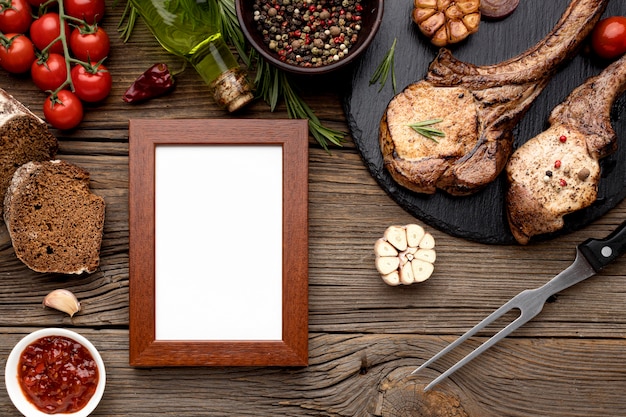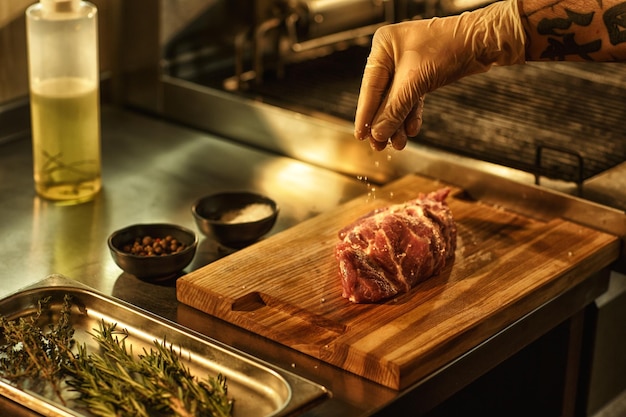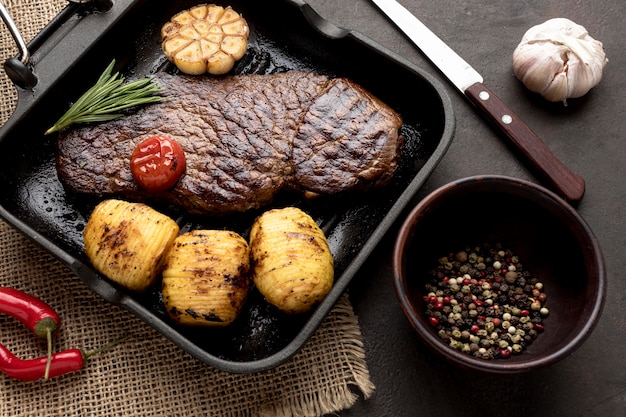Let's talk steak, shall we? You know, that juicy, flavorful piece of meat that makes you lick your plate clean. I'm talking about that perfect medium to well-done steak, the kind that’s cooked just right, offering a delicious balance of tenderness and a satisfying chew.
Now, I've been a bit of a steak enthusiast for years. I've grilled, pan-fried, and even smoked my fair share of cuts, experimenting with different cooking techniques and temperatures. And trust me, there's nothing more disheartening than biting into a dry, tough piece of meat that was overcooked.
So, I decided to put together this comprehensive guide, sharing everything I've learned about achieving that perfect medium to well-done steak. We'll delve into the science of cooking steak, explore different cuts and their best cooking methods, and cover everything from selecting the right steak to mastering the art of resting it.
This isn't just about following recipes; it's about understanding the process, building confidence, and becoming a steak-cooking master in your own kitchen. Ready? Let's get started!
(Part 1) The Science Behind Steak

Understanding the Maillard Reaction
You know that lovely brown crust on a perfectly cooked steak? That's the magic of the Maillard reaction. It's a chemical process that happens when the proteins and sugars in meat are exposed to high heat, creating hundreds of flavour compounds. It's a bit like alchemy in the kitchen, transforming simple ingredients into something truly delicious.
Imagine this: when you sear a steak, the intense heat breaks down the protein molecules, and they react with the sugars. This process produces those delicious brown, caramelized flavours that we all crave. Think of it like the difference between a plain, white loaf of bread and a crusty, golden brown baguette. The Maillard reaction is the key to that beautiful browning and rich flavour.
The Maillard reaction happens most effectively at temperatures between 140°C and 165°C (284°F and 329°F). This is why a hot pan or grill is essential for achieving that perfect crust.
The Role of Fat
Fat plays a crucial role in both the flavour and tenderness of steak. Think about the marbling you see in a good cut of beef - that's fat running through the muscle, adding flavour and juiciness. It's like the hidden ingredient that makes all the difference.
As the fat renders during cooking, it adds moisture and richness to the meat. It's the fat that helps to keep the steak tender and juicy, preventing it from drying out.
Protein and Moisture
Steak is essentially muscle tissue, made up of proteins and water. When you cook steak, the proteins start to denature, or break down, causing the meat to firm up. Think of it like a sponge soaking up water. The proteins are the sponge, and the water is the moisture.
But it's all about timing. If you cook the steak too long, the proteins contract too much, squeezing out moisture and leaving you with a dry, tough piece of meat. It's like wringing out a sponge - all the water is gone, and you're left with a dry, hard piece.
(Part 2) choosing the right steak

Understanding Cuts
The first step to achieving a perfect steak is choosing the right cut. Think of it like selecting the right ingredient for a recipe. Each cut has its own unique characteristics and is best suited for different cooking methods.
Here's a breakdown of some popular cuts, their characteristics, and their best cooking methods:
1. Ribeye: Known for its marbling and rich flavour, ribeye is a favourite for grilling or pan-frying. It's a relatively thick cut, so it holds up well to higher temperatures.
2. new york strip: Leaner than ribeye, New York strip has a more pronounced flavour and a firmer texture. It's great for pan-frying, grilling, or broiling.
3. filet mignon: This tender, lean cut is prized for its buttery texture and mild flavour. It's best cooked to medium-rare or medium, as it can become dry if overcooked.
4. Sirloin: A good all-around choice, sirloin is a bit tougher than ribeye or filet mignon, but it still offers a good amount of flavour and marbling. It's suitable for grilling, pan-frying, or roasting.
5. skirt steak: This thin, flavorful cut is perfect for grilling or stir-frying. It cooks quickly and has a slightly chewy texture.
Thickness Matters
The thickness of the steak also plays a crucial role. Imagine cooking a thin pancake compared to a thick, fluffy cake. The thinner pancake will cook much faster than the cake.
Thicker cuts require longer cooking times to reach the desired doneness, while thinner cuts cook much faster. You need to adjust your cooking time based on the thickness of the steak to ensure it's cooked evenly.
Quality Matters
Always choose a steak from a reputable butcher or supermarket. Look for a good amount of marbling, a rich colour, and a firm texture. It's like choosing the best ingredients for any other dish. The higher the quality of the steak, the better the final result will be.
(Part 3) Getting Ready to Cook

Bringing the Steak to Room Temperature
Before you start cooking, let your steak rest at room temperature for 30-60 minutes. This allows the steak to cook more evenly and prevents it from being cold in the centre. Think of it like preheating your oven - it allows the steak to cook more consistently, resulting in a more evenly cooked piece of meat.
Seasoning: The Key to Flavor
Salt and pepper are essential for enhancing the natural flavours of the steak. Season generously, about 30 minutes before cooking, to allow the salt to penetrate the meat. It's like adding a pinch of magic to your steak. Salt helps to draw out the moisture, creating a more flavorful and tender steak.
Other Seasoning Options
You can also experiment with other seasonings like garlic powder, onion powder, paprika, or even a blend of herbs. It's a great way to add your own personal touch to your steak. Think of it as a way to create your own signature flavor profile.
(Part 4) Cooking Techniques for the Perfect Steak
Grilling: A Classic Method
Grilling is a great way to achieve a crispy exterior and a juicy interior. Think of it as the ultimate outdoor cooking experience. The hot grill creates those beautiful grill marks and adds a smoky flavour that's hard to resist.
Preheat your grill to high heat, and make sure the grates are clean and well-oiled. This ensures that the steak doesn't stick to the grill and allows it to sear properly.
Pan-Frying: Easy and Versatile
Pan-frying is a convenient and quick method. Think of it as the indoor alternative to grilling. It's perfect for those nights when you don't want to fire up the grill.
Heat a heavy-bottomed pan over medium-high heat and add a tablespoon of oil. Sear the steak for 2-3 minutes per side, or until a nice crust forms.
reverse searing: For Tender and Juicy Results
Reverse searing is a great technique for achieving a perfectly tender and juicy steak. It involves cooking the steak in a low oven for a longer period, followed by a quick sear on the stovetop. Think of it as the ultimate way to achieve perfect tenderness and juiciness.
The slow cooking in the oven helps to cook the steak evenly throughout, while the quick sear at the end creates a delicious crust.
Broiling: A Fast and Efficient Method
Broiling is a great way to cook a steak quickly. Think of it as a shortcut to a perfectly cooked steak. It's perfect for those nights when you're short on time.
Preheat your broiler to high heat, and place the steak on a baking sheet. Broil for 3-4 minutes per side, or until the steak is cooked to your liking.
(Part 5) Achieving the Perfect Doneness
Understanding Doneness Levels
Doneness refers to the internal temperature of the steak. Think of it like the sweet spot for your steak. Each level of doneness has its own unique texture and flavour.
Here's a guide to the different levels:
Rare: 125°F (52°C) - The centre will be cool and red, with a firm texture.
Medium-Rare: 130°F (54°C) - The centre will be slightly warm, with a slight red hue and a tender texture.
Medium: 140°F (60°C) - The centre will be warm, with a pink hue and a more firm texture.
Medium-Well: 150°F (65°C) - The centre will be warm, with a slight pink hue and a firm texture.
Well-Done: 160°F (71°C) - The centre will be hot, with no pink hue and a very firm texture.
Using a meat thermometer
The most accurate way to determine doneness is to use a meat thermometer. Insert the thermometer into the thickest part of the steak, making sure it doesn't touch bone. Think of it as a science experiment for your steak. It takes the guesswork out of cooking and ensures that your steak is cooked to perfection.
Visual Indicators
You can also use visual indicators to gauge doneness. Think of it as a visual cue to tell you when your steak is ready. But remember, it's not as reliable as using a thermometer.
Rare: The surface will be brown, and the centre will be red.
Medium-Rare: The surface will be brown, and the centre will be pink.
Medium: The surface will be brown, and the centre will be pink, but the pink will be less pronounced.
Medium-Well: The surface will be brown, and the centre will be slightly pink.
Well-Done: The surface will be brown, and the centre will be grey.
The Finger Test (Not as Reliable)
There's a popular finger test method, but it's not as accurate as using a thermometer. Press the palm of your hand near your thumb, the fleshy part. This will feel like a rare steak. Now, press near your index finger, the fleshy part. This will feel like a medium-rare steak. Continue down your fingers to compare to other doneness levels.
Think of it as a rough guide, but it's not a substitute for using a thermometer. It's best to use this method only if you don't have a thermometer on hand.
(Part 6) Resting Your Steak
Why Resting is Crucial
After you've cooked your steak, it's essential to let it rest for 5-10 minutes before cutting into it. Think of it as a crucial step to ensure that your steak is juicy and tender.
This allows the juices to redistribute throughout the steak, ensuring that it's incredibly tender and juicy. It's like giving the steak a chance to relax and recover after the intense cooking process.
How to Rest Your Steak
Cover the steak loosely with foil and set it aside on a cutting board. The foil helps to trap the heat and moisture, allowing the juices to redistribute evenly.
(Part 7) Serving and Enjoying Your Steak
Cutting and Serving
Cut the steak against the grain, which means slicing perpendicular to the muscle fibres. This helps to tenderize the steak and makes it easier to chew. Think of it like cutting a piece of string. Cutting against the grain makes it easier to bite through and digest.
side dishes for Your Steak
Serve your steak with a variety of side dishes, such as mashed potatoes, roasted vegetables, or a simple salad. Think of it as creating a symphony of flavours. The side dishes complement the steak and add to the overall dining experience.
Enjoy Your Masterpiece!
Once you've created the perfect steak, take a moment to savour the flavour and texture. It's like celebrating a culinary triumph. Take your time, enjoy the moment, and appreciate the hard work you've put into crafting the perfect steak.
(Part 8) steak sauces and Toppings
Steak Sauce Options
There are endless possibilities when it comes to steak sauces. Think of it as the finishing touch to your steak. It can enhance the flavour or create a completely new taste sensation.
Here are a few classic options:
Béarnaise Sauce: A rich and creamy sauce made with butter, egg yolks, vinegar, and tarragon. It's like a luxurious, tangy sauce that adds a touch of elegance to your steak.
Peppercorn Sauce: A spicy and flavorful sauce made with peppercorns, brandy, and cream. It's a perfect match for those who enjoy a bit of heat and complexity.
Red Wine Sauce: A classic and elegant sauce made with red wine, shallots, and herbs. It's a rich and savory sauce that adds a touch of sophistication to your steak.
Mushroom Sauce: A hearty and savory sauce made with mushrooms, onions, and cream. It's a perfect choice for those who love mushrooms and want a more robust sauce.
Steak Toppings
You can also add some toppings to your steak, such as:
Blue Cheese Crumbles: For a pungent and creamy topping. It's a perfect choice for those who love blue cheese and its bold flavour.
caramelized onions: For a sweet and savory topping. They add a touch of sweetness and depth to the steak.
Roasted Garlic: For a garlicky and flavorful topping. It's a simple yet delicious topping that adds a burst of flavour to your steak.
(Part 9) FAQs
Q1: What's the best way to prevent a steak from becoming dry?
The best way to prevent a steak from becoming dry is to cook it to the appropriate doneness. Avoid overcooking, and remember to rest the steak after cooking to allow the juices to redistribute.
Q2: Can I cook steak in a slow cooker?
While it's possible, slow cooking is not ideal for steaks. The long cooking times can result in tough, dry meat.
Q3: What's the best way to grill a steak?
Preheat your grill to high heat, and make sure the grates are clean and well-oiled. Sear the steak for 2-3 minutes per side, then reduce the heat to medium and cook for another 4-6 minutes per side, or until the steak is cooked to your liking.
Q4: What's the best way to pan-fry a steak?
Heat a heavy-bottomed pan over medium-high heat and add a tablespoon of oil. Sear the steak for 2-3 minutes per side, or until a nice crust forms. Then, reduce the heat to medium and cook for another 4-6 minutes per side, or until the steak is cooked to your liking.
Q5: How do I choose the right cut of meat for my desired level of doneness?
Different cuts of steak have different levels of tenderness and marbling. Thicker cuts are better suited for medium to well-done, while thinner cuts are better suited for rare to medium-rare.
Conclusion:
Mastering the art of cooking steak is a journey, but one that's definitely worth taking. With a bit of practice and these tips, you'll be grilling, pan-frying, and broiling delicious steaks in no time! Just remember to have fun, experiment, and most importantly, enjoy your culinary creations.
Everyone is watching

How to Cook Frozen Lobster Tails Perfectly: A Step-by-Step Guide
RecipesLobster. Just the word conjures up images of lavish meals, special occasions, and a taste of luxury. But let's...

Pigs in a Blanket Cooking Time: How Long to Bake for Perfect Results
RecipesAh, pigs in a blanket. Just the name conjures up images of those delightful little parcels of crispy pastry en...

Pork Fillet Cooking Time: How Long to Cook It Perfectly
RecipesPork fillet, or tenderloin as it's sometimes called, is a real favourite in our house. It's so versatile, and...

The Ultimate Guide to Cooking Delicious Frankfurters
RecipesLet's face it, we all love a good frankfurter. It's a classic, simple, and always satisfying. But let's be rea...

Wolf Meat Recipes: A Guide to Cooking Wild Game
RecipesLet's be honest, you don't see wolf meat at your local butcher shop every day. It's a bit of a wild card, but ...
